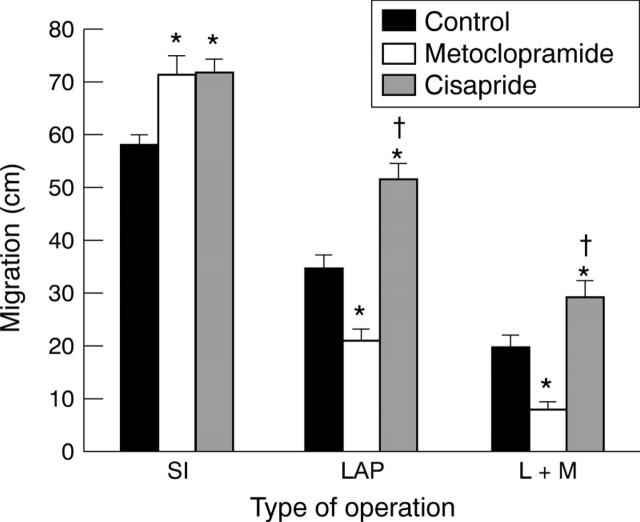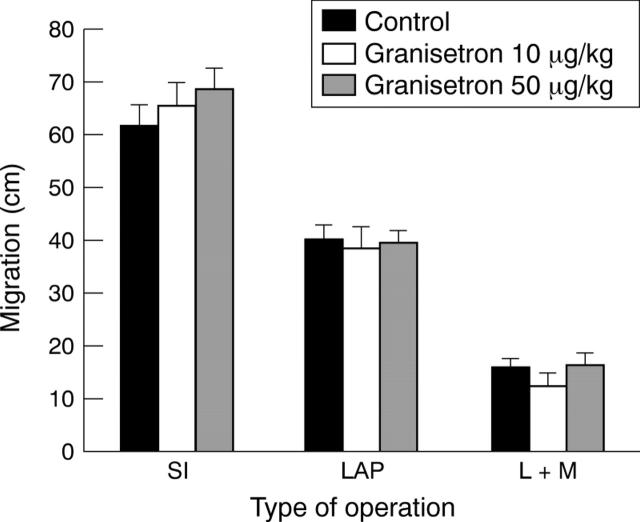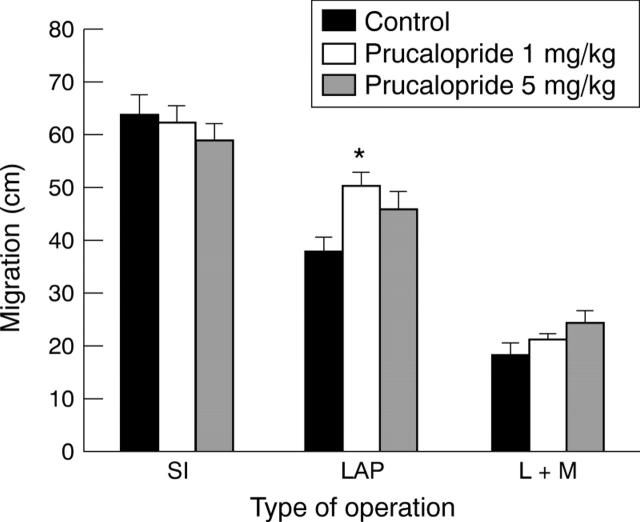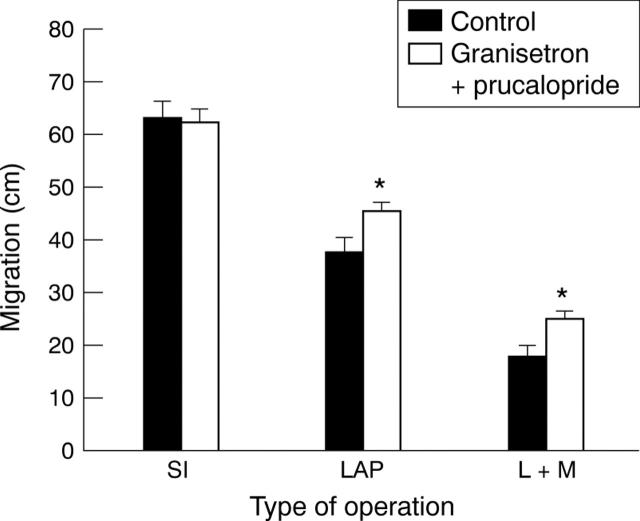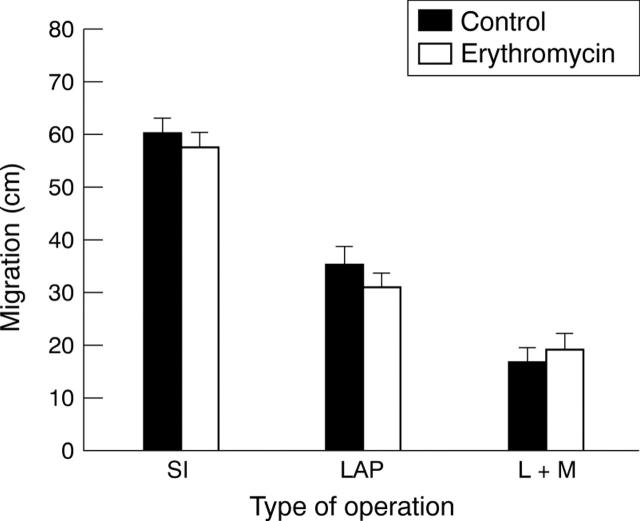Abstract
BACKGROUND/AIM—The effects of different prokinetic agents, the motilide erythromycin and the substituted benzamides metoclopramide and cisapride, were investigated in a rat model of postoperative ileus. These effects were compared with that of granisetron, a 5-hydroxytryptamine (5-HT3) receptor antagonist, and a novel enterokinetic agent, prucalopride, a 5-HT4 receptor agonist. METHODS—Different degrees of inhibition of gastrointestinal transit, measured by the migration of Evans blue, were achieved by skin incision, laparotomy, or laparotomy plus mechanical stimulation of the gut. RESULTS—Metoclopramide decreased the transit after laparotomy with or without mechanical stimulation, whereas cisapride increased it after all three operations. Granisetron had no effect on the transit after the three operations when given alone. Prucalopride tended to increase the transit after laparotomy with or without mechanical stimulation when given alone. However, statistical significance was only reached when prucalopride was combined with granisetron. Erythromycin, a motilin receptor agonist, did not improve postoperative ileus in the rat. CONCLUSIONS—Cisapride, but not metoclopramide or erythromycin, is able to improve postoperative ileus in the rat. The results suggest that a combination of 5-HT3 receptor antagonist and 5-HT4 receptor agonist properties may be required to obtain a beneficial effect on surgery induced ileus in the rat. Furthermore, they indirectly indicate that stimulation of the excitatory mechanisms is not able to overcome the inhibitory influence of the neural reflex pathways activated during abdominal surgery. Keywords: ileus; motilin; cisapride; metoclopramide; 5-HT3 receptor; 5-HT4 receptor
Full Text
The Full Text of this article is available as a PDF (107.9 KB).
Figure 1 .
Effect of skin incision (SI), laparotomy (LAP), or laparotomy plus mechanical stimulation of the small intestine and caecum (L+M) on intestinal transit in control rats (n = 9-10) and rats treated with metoclopramide (30 mg/kg; n = 9) or cisapride (1 mg/kg; n = 9-10). Results are expressed as cm migration of Evans blue and shown as mean (SEM). *Significantly different from the transit in control rats with the same operation (p⩽0.05); †significantly different from the transit in rats treated with metoclopramide with the same operation (p⩽0.05) (one way analysis of variance followed by the Bonferroni test).
Figure 2 .
Effect of skin incision (SI), laparotomy (LAP), or laparotomy plus mechanical stimulation of the small intestine and caecum (L+M) on intestinal transit in control rats (n = 9-10) and rats treated with granisetron 10 µg/kg (n = 9) or 50 µg/kg (n = 9-10). Results are expressed as cm migration of Evans blue and shown as mean (SEM). One way analysis of variance could not detect any significant differences between the treatment groups.
Figure 3 .
Effect of skin incision (SI), laparotomy (LAP), or laparotomy plus mechanical stimulation of the small intestine and caecum (L+M) on intestinal transit in control rats (n = 9) and in rats treated with prucalopride 1 mg/kg (n = 9) or 5 mg/kg (n = 9). Results are expressed as cm migration of Evans blue and shown as mean (SEM). *Significantly different from the transit in control rats after laparotomy (p⩽0.05) (one way analysis of variance followed by the Bonferroni test).
Figure 4 .
Effect of skin incision (SI), laparotomy (LAP), or laparotomy plus mechanical stimulation of the small intestine and caecum (L+M) on intestinal transit in control rats (n = 10) and rats treated with a combination of granisetron (50 µg/kg) and prucalopride (1 mg/kg) (n = 9-10). Results are expressed as cm migration of Evans blue and shown as mean (SEM). *Significantly different from the transit in control rats with the same operation (p⩽0.05) (unpaired Student's t test).
Figure 5 .
Effect of skin incision (SI), laparotomy (LAP), or laparotomy plus mechanical stimulation of the small intestine and caecum (L+M) on intestinal transit in control rats (n = 9) and rats treated with erythromycin (1 mg/kg; n = 9). Results are expressed as cm migration of Evans blue and shown as mean (SEM). Unpaired Student's t test could not detect any significant differences between the treatment groups.
Selected References
These references are in PubMed. This may not be the complete list of references from this article.
- Albibi R., McCallum R. W. Metoclopramide: pharmacology and clinical application. Ann Intern Med. 1983 Jan;98(1):86–95. doi: 10.7326/0003-4819-98-1-86. [DOI] [PubMed] [Google Scholar]
- Annese V., Janssens J., Vantrappen G., Tack J., Peeters T. L., Willemse P., Van Cutsem E. Erythromycin accelerates gastric emptying by inducing antral contractions and improved gastroduodenal coordination. Gastroenterology. 1992 Mar;102(3):823–828. doi: 10.1016/0016-5085(92)90164-t. [DOI] [PubMed] [Google Scholar]
- Appel S., Kumle A., Hubert M., Duvauchelle T. First pharmacokinetic-pharmacodynamic study in humans with a selective 5-hydroxytryptamine4 receptor agonist. J Clin Pharmacol. 1997 Mar;37(3):229–237. doi: 10.1002/j.1552-4604.1997.tb04785.x. [DOI] [PubMed] [Google Scholar]
- Benson M. J., Roberts J. P., Wingate D. L., Rogers J., Deeks J. J., Castillo F. D., Williams N. S. Small bowel motility following major intra-abdominal surgery: the effects of opiates and rectal cisapride. Gastroenterology. 1994 Apr;106(4):924–936. doi: 10.1016/0016-5085(94)90751-x. [DOI] [PubMed] [Google Scholar]
- Boghaert A., Haesaert G., Mourisse P., Verlinden M. Placebo-controlled trial of cisapride in postoperative ileus. Acta Anaesthesiol Belg. 1987;38(3):195–199. [PubMed] [Google Scholar]
- Bonacini M., Quiason S., Reynolds M., Gaddis M., Pemberton B., Smith O. Effect of intravenous erythromycin on postoperative ileus. Am J Gastroenterol. 1993 Feb;88(2):208–211. [PubMed] [Google Scholar]
- Briejer M. R., Akkermans L. M., Schuurkes J. A. Gastrointestinal prokinetic benzamides: the pharmacology underlying stimulation of motility. Pharmacol Rev. 1995 Dec;47(4):631–651. [PubMed] [Google Scholar]
- Bueno L., Ferre J. P., Ruckebusch Y. Effects of anesthesia and surgical procedures on intestinal myoelectric activity in rats. Am J Dig Dis. 1978 Aug;23(8):690–695. doi: 10.1007/BF01072353. [DOI] [PubMed] [Google Scholar]
- Costa A., De Ponti F., Gibelli G., Crema F., d'Angelo L. In vivo characterization of the colonic prokinetic effect of erythromycin in the rabbit. Pharmacology. 1997 Feb;54(2):64–75. doi: 10.1159/000139471. [DOI] [PubMed] [Google Scholar]
- De Winter B. Y., Boeckxstaens G. E., De Man J. G., Moreels T. G., Herman A. G., Pelckmans P. A. Effect of adrenergic and nitrergic blockade on experimental ileus in rats. Br J Pharmacol. 1997 Feb;120(3):464–468. doi: 10.1038/sj.bjp.0700913. [DOI] [PMC free article] [PubMed] [Google Scholar]
- Dowling P. M. Prokinetic drugs: metoclopramide and cisapride. Can Vet J. 1995 Feb;36(2):115–116. [PMC free article] [PubMed] [Google Scholar]
- Emmanuel A. V., Kamm M. A., Roy A. J., Antonelli K. Effect of a novel prokinetic drug, R093877, on gastrointestinal transit in healthy volunteers. Gut. 1998 Apr;42(4):511–516. doi: 10.1136/gut.42.4.511. [DOI] [PMC free article] [PubMed] [Google Scholar]
- Foxx-Orenstein A. E., Kuemmerle J. F., Grider J. R. Distinct 5-HT receptors mediate the peristaltic reflex induced by mucosal stimuli in human and guinea pig intestine. Gastroenterology. 1996 Nov;111(5):1281–1290. doi: 10.1053/gast.1996.v111.pm8898642. [DOI] [PubMed] [Google Scholar]
- García-Garayoa E., Monge A., Roca J., Del Río J., Lasheras B. VB20B7, a novel 5-HT-ergic agent with gastrokinetic activity. II. Evaluation of the gastroprokinetic activity in rats and dogs. J Pharm Pharmacol. 1997 Jan;49(1):66–73. doi: 10.1111/j.2042-7158.1997.tb06754.x. [DOI] [PubMed] [Google Scholar]
- Hallerbäck B., Bergman B., Bong H., Ekström P., Glise H., Lundgren K., Risberg O. Cisapride in the treatment of post-operative ileus. Aliment Pharmacol Ther. 1991 Oct;5(5):503–511. doi: 10.1111/j.1365-2036.1991.tb00519.x. [DOI] [PubMed] [Google Scholar]
- Hegde S. S., Eglen R. M. Peripheral 5-HT4 receptors. FASEB J. 1996 Oct;10(12):1398–1407. doi: 10.1096/fasebj.10.12.8903510. [DOI] [PubMed] [Google Scholar]
- Hegde S. S., Wong A. G., Perry M. R., Ku P., Moy T. M., Loeb M., Eglen R. M. 5-HT4 receptor mediated stimulation of gastric emptying in rats. Naunyn Schmiedebergs Arch Pharmacol. 1995 Jun;351(6):589–595. doi: 10.1007/BF00170157. [DOI] [PubMed] [Google Scholar]
- Ito C., Isobe Y., Tsuchida K., Higuchi S. 5-Hydroxytryptamine3 receptor and regulation of gastric emptying in rats. Arch Int Pharmacodyn Ther. 1996 Mar-Apr;331(2):203–218. [PubMed] [Google Scholar]
- Itoh Z. Motilin and clinical application. Peptides. 1997;18(4):593–608. doi: 10.1016/s0196-9781(96)00333-6. [DOI] [PubMed] [Google Scholar]
- Janssens J., Peeters T. L., Vantrappen G., Tack J., Urbain J. L., De Roo M., Muls E., Bouillon R. Improvement of gastric emptying in diabetic gastroparesis by erythromycin. Preliminary studies. N Engl J Med. 1990 Apr 12;322(15):1028–1031. doi: 10.1056/NEJM199004123221502. [DOI] [PubMed] [Google Scholar]
- Jepsen S., Klaerke A., Nielsen P. H., Simonsen O. Negative effect of Metoclopramide in postoperative adynamic ileus. A prospective, randomized, double blind study. Br J Surg. 1986 Apr;73(4):290–291. doi: 10.1002/bjs.1800730414. [DOI] [PubMed] [Google Scholar]
- Livingston E. H., Passaro E. P., Jr Postoperative ileus. Dig Dis Sci. 1990 Jan;35(1):121–132. doi: 10.1007/BF01537233. [DOI] [PubMed] [Google Scholar]
- Megens A. A., Awouters F. H., Niemegeers C. J. General pharmacology of the four gastrointestinal motility stimulants bethanechol, metoclopramide, trimebutine, and cisapride. Arzneimittelforschung. 1991 Jun;41(6):631–634. [PubMed] [Google Scholar]
- Minocha A., Katragadda R., Rahal P. S., Ries A. Erythromycin shortens orocaecal transit time in diabetic male subjects: a double-blind placebo-controlled study. Aliment Pharmacol Ther. 1995 Oct;9(5):529–533. doi: 10.1111/j.1365-2036.1995.tb00416.x. [DOI] [PubMed] [Google Scholar]
- Nagakura Y., Ito H., Kiso T., Naitoh Y., Miyata K. The selective 5-hydroxytryptamine (5-HT)4-receptor agonist RS67506 enhances lower intestinal propulsion in mice. Jpn J Pharmacol. 1997 Jun;74(2):209–212. doi: 10.1254/jjp.74.209. [DOI] [PubMed] [Google Scholar]
- Nguyen A., Camilleri M., Kost L. J., Metzger A., Sarr M. G., Hanson R. B., Fett S. L., Zinsmeister A. R. SDZ HTF 919 stimulates canine colonic motility and transit in vivo. J Pharmacol Exp Ther. 1997 Mar;280(3):1270–1276. [PubMed] [Google Scholar]
- Pawlik W. W., Gustaw P., Thor P., Sendur R., Czarnobilski K., Hottenstein O. D., Konturek S. J. Microcirculatory and motor effects of endogenous nitric oxide in the rat gut. J Physiol Pharmacol. 1993 Jun;44(2):139–146. [PubMed] [Google Scholar]
- Peeters T. L., Depoortere I. Motilin receptor: a model for development of prokinetics. Dig Dis Sci. 1994 Dec;39(12 Suppl):76S–78S. doi: 10.1007/BF02300377. [DOI] [PubMed] [Google Scholar]
- Peeters T. L. Erythromycin and other macrolides as prokinetic agents. Gastroenterology. 1993 Dec;105(6):1886–1899. doi: 10.1016/0016-5085(93)91089-z. [DOI] [PubMed] [Google Scholar]
- Peeters T., Matthijs G., Depoortere I., Cachet T., Hoogmartens J., Vantrappen G. Erythromycin is a motilin receptor agonist. Am J Physiol. 1989 Sep;257(3 Pt 1):G470–G474. doi: 10.1152/ajpgi.1989.257.3.G470. [DOI] [PubMed] [Google Scholar]
- Resnick J., Greenwald D. A., Brandt L. J. Delayed gastric emptying and postoperative ileus after nongastric abdominal surgery: part II. Am J Gastroenterol. 1997 Jun;92(6):934–940. [PubMed] [Google Scholar]
- Schiavone A., Volonté M., Micheletti R. The gastrointestinal motor effect of benzamide derivatives is unrelated to 5-HT3 receptor blockade. Eur J Pharmacol. 1990 Oct 23;187(3):323–329. doi: 10.1016/0014-2999(90)90359-e. [DOI] [PubMed] [Google Scholar]
- Shibata Y., Toyoda S. Effects of prostaglandin F2alpha and cisapride on small intestinal activity during the early postoperative period in humans. Surg Today. 1998;28(8):787–791. doi: 10.1007/s005950050227. [DOI] [PubMed] [Google Scholar]
- Song C. W., Lee K. Y., Kim C. D., Chang T. M., Chey W. Y. Effect of cisapride and renzapride on gastrointestinal motility and plasma motilin concentration in dogs. J Pharmacol Exp Ther. 1997 Jun;281(3):1312–1316. [PubMed] [Google Scholar]
- Tanila H., Kauppila T., Taira T. Inhibition of intestinal motility and reversal of postlaparotomy ileus by selective alpha 2-adrenergic drugs in the rat. Gastroenterology. 1993 Mar;104(3):819–824. doi: 10.1016/0016-5085(93)91018-d. [DOI] [PubMed] [Google Scholar]
- Tollesson P. O., Cassuto J., Rimbäck G., Faxén A., Bergman L., Mattsson E. Treatment of postoperative paralytic ileus with cisapride. Scand J Gastroenterol. 1991 May;26(5):477–482. doi: 10.3109/00365529108998569. [DOI] [PubMed] [Google Scholar]
- Tonini M. Recent advances in the pharmacology of gastrointestinal prokinetics. Pharmacol Res. 1996 Apr-May;33(4-5):217–226. doi: 10.1006/phrs.1996.0030. [DOI] [PubMed] [Google Scholar]
- Verlinden M., Michiels G., Boghaert A., de Coster M., Dehertog P. Treatment of postoperative gastrointestinal atony. Br J Surg. 1987 Jul;74(7):614–617. doi: 10.1002/bjs.1800740727. [DOI] [PubMed] [Google Scholar]



